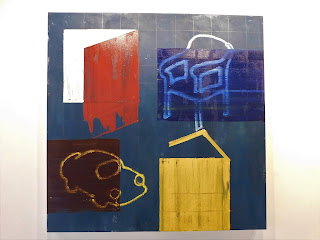Metascores (rhymes with…)
 |
| Chorus: 34 Drag Chute |
 |
| Chorus: Little Nova Rocker |
 |
| Chorus: Singing Through a Hole |
 |
| Chorus: Singing Through the Fence |
 |
| Chorus: Singing on President's Day |
 |
| Chorus: Gold Finch Song |
By Tom Wachunas
“A painter… in his longing to express his inner life,
cannot but envy the ease with which music, the most non-material of the arts
today, achieves this end. He naturally seeks to apply the methods of music to
his own art. And from this results that modern desire for rhythm in painting,
for mathematical, abstract construction, for repeated notes of colour, for
setting colour in motion.”
― Wassily Kandinsky, from Concerning the Spiritual in Art
EXHIBIT: Chorus and Understudy, An Invitation to Look –
29 paintings by Earl Iselin / at The William J. and Pearl F. Lemmon Visiting
Artist Gallery, located in the Fine Arts Building at Kent University at Stark /
6000 Frank Avenue NW, North Canton, OH / THROUGH OCTOBER 29, 2021 /
Gallery Hours Monday – Friday, 11 a.m. – 5 p.m. (NOT OPEN on Friday, Oct. 15)
FOR MORE INFORMATION, CONTACT JACK MCWHORTER AT 330-244-3356
OR JMCWHORT@KENT.EDU.
Artist Reception and Gallery Talk – THURSDAY OCTOBER 21 - 5:30 – 7:30 p.m.
In a recent
statement about his work, Earl Iselin wrote about a seminal encounter from his
days as an undergrad at Kent State University. While there, he often visited
Robert Smithson’s land art installation, Partially Buried Woodshed, made
on the University grounds in 1970. Sitting inside the entropic structure (i.e.,
designed by Smithson to disintegrate over time) induced a sensation of being
buried alive. In that setting, Iselin’s view of the sky – a signifier of
possibility for fully experiencing a present moment – was obstructed.
That memory
resonates in his poetic philosophizing about painting. What he has called
“skying the painting” speaks to the purpose of his pictures. “To be at home
in painting means to defy the past,” he tells us, adding, “Every
generation has to come to painting for itself. Every generation must go through
the labor of off-loading in order to find what is appropriate for them, to
unemcumber their work. We have to decide what we will take with us into the
present, and what we will leave behind. Our inspiration must find lift.”
Looking at these paintings brings to mind the
phenomenon of synesthesia, from the Greek syn, meaning
"together", and aisthesis, meaning "sensation."
Synesthesia happens when one sensory or cognitive process is stimulated enough
to cause a simultaneous perception or experience in another sense or cognitive
pathway.
A recurring pathway in Iselin’s paintings is
the grid. It’s a motif apparent in much of modernist painting history, and one
that can codify any number of contexts, including architectural constructions,
urban landscapes, maps, measured units of time, or the very idea of repeated patterns
found in nature.
Iselin’s grids vary widely in terms of their
rigidity and clarity. There are painterly, tactile actions – both representational
and purely gestural or abstract – resting under, intertwined through, or placed
directly on top of the grids. Faces, places, or objects – faded or fading,
softly in the past, or loudly in the present. Balance and counterbalance. Seen
and… heard?
The titles of these
paintings are intriguing. Most of them suggest a musicality, beginning with the
word ‘Chorus’ followed by a reference to a specific subject. Voices singing and
continuously interwoven. Iselin’s use of the grid as a delineated system for containing
his marks and shapes is not so far removed from how a composer scores a musical
work via a staff - the horizontal, 5-lined configuration for attaching or
mapping the various signs and symbols that articulate melodies and harmonies,
pace and rhythms, or durations in time.
So here’s an
invitation to not only look, but perhaps to listen as well. Iselin’s paintings
are, on one fascinating level, scores written for the instrument of his
imagination and yours. To look at this impressive collection is to join a
choir and…find lift.
No comments:
Post a Comment